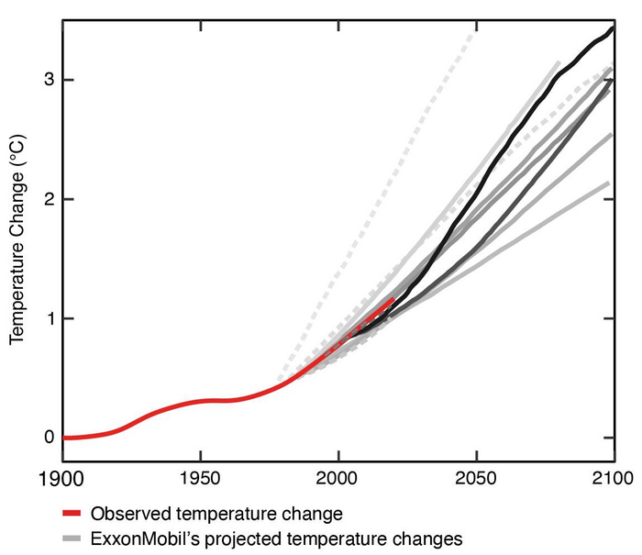ExxonMobil – formerly known as Exxon, and one of the world's leading oil and gas companies – had the numbers on climate change way back in 1977, according to a recent review of internal documents held secret by the company for nearly five decades.
In 2015, investigative journalists from the Los Angeles Times and The Guardian made a shocking discovery. They found dozens of internal documents from Exxon and ExxonMobil scientists that clearly detailed how fossil fuel products contributed to the global climate crisis – which could have "dramatic environmental effects before the year 2050".
Since these reports were first leaked, researchers have pored over and carefully analyzed the conclusions, mostly to point out the hypocrisy of ExxonMobil's decades-long campaign to deny the science of climate change.
Yet the exact numbers and graphs projected by industry-led scientists haven't faced the same level of scrutiny, even though they seem to be tracking closely with fossil fuel emissions and global warming today.
Researchers at Harvard University are the now first to evaluate how the outputs of ExxonMobil's internal climate models aligned with the actual scientific literature and our climate reality.
In the end, the authors found between 63 and 93 percent of the company's concealed projections produced between 1977 and 2003 were correct.
The graph below shows how well the projections line up with historically observed temperature changes.

"Our findings demonstrate that ExxonMobil didn't just know 'something' about global warming decades ago – they knew as much as academic and government scientists knew," the authors write.
"These findings corroborate and add quantitative precision to assertions by scholars, journalists, lawyers, politicians, and others that ExxonMobil accurately foresaw the threat of human-caused global warming, both prior and parallel to orchestrating lobbying and propaganda campaigns to delay climate action," they add.
The analysis is based on 32 internal documents produced by scientists at Exxon and ExxonMobil between 1977 and 2002 (the company Exxon merged with Mobil Oil Corp in 1999 to become ExxonMobil).
This data was then compared to 72 independent, peer-reviewed scientific papers Exxon and ExxonMobil scientists produced between 1982 and 2013.
On average, ExxonMobil's projected rate of warming was about 0.20°C a decade. That's roughly the same estimate that independent scientists and governments put forward in their own models.
Given the rate of human-produced carbon emissions, ExxonMobil scientists also predicted that the effects of the climate crisis would first become apparent at the turn of the century.
And so they did, even as ExxonMobil spokespeople denied the reality the company knew was unfolding.
In fact, compared to the climate models presented by NASA scientists to US Congress in 1988, the company's predictions were even more skillfully designed, Harvard researchers found.
For almost five decades now, officials at ExxonMobil have tried to sow doubt by arguing that climate models are based on too many uncertainties to be reliable. For instance, in 1999, the CEO claimed that climate models were often based on "sheer speculation".
But as it turns out, the uncertainty in ExxonMobil's own internal research is the same as what independent climate scientists were finding – and is an accepted part of climate modeling that is steadily refined with every passing year.
"This is the nail in the coffin of ExxonMobil's claims that it has been falsely accused of climate malfeasance," says science historian and lead author of the study Geoffrey Supran, who is now at the University of Miami.
"Our analysis shows that ExxonMobil's own data contradicted its public statements, which included exaggerating uncertainties, criticizing climate models, mythologizing global cooling, and feigning ignorance about when – or if – human-caused global warming would be measurable, all while staying silent on the threat of stranded fossil fuel assets."
Officials at Exxon knew what the world was headed for. They just didn't seem to care.
The study was published in Science.
